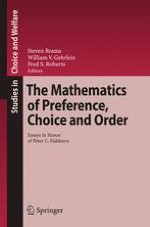Peter Fishburn has had a splendidly productive career that led to path-breaking c- tributions in a remarkable variety of areas of research. His contributions have been published in a vast literature, ranging through journals of social choice and welfare, decision theory, operations research, economic theory, political science, mathema- cal psychology, and discrete mathematics. This work was done both on an individual basis and with a very long list of coauthors. The contributions that Fishburn made can roughly be divided into three major topical areas, and contributions to each of these areas are identi?ed by sections of this monograph. Section 1 deals with topics that are included in the general areas of utility, preference, individual choice, subjective probability, and measurement t- ory. Section 2 covers social choice theory, voting models, and social welfare. S- tion 3 deals with more purely mathematical topics that are related to combinatorics, graph theory, and ordered sets. The common theme of Fishburn’s contributions to all of these areas is his ability to bring rigorous mathematical analysis to bear on a wide range of dif?cult problems.
